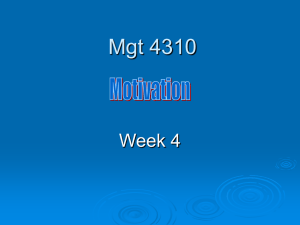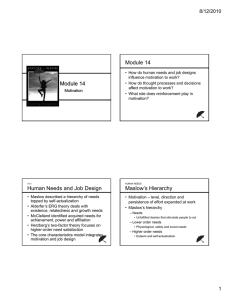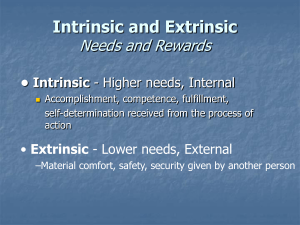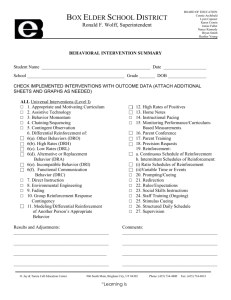module 19 motivation
advertisement
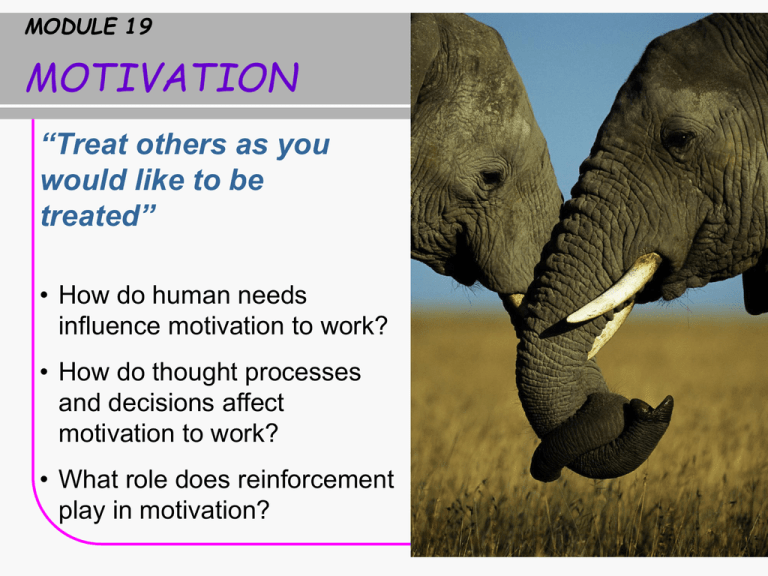
MODULE 19 MOTIVATION “Treat others as you would like to be treated” • How do human needs influence motivation to work? • How do thought processes and decisions affect motivation to work? • What role does reinforcement play in motivation? MOTIVATION Human Needs MODULE GUIDE 19.1 Maslow described a hierarchy of needs topped by self-actualization. Alderfer’s ERG theory focuses on existence, relatedness, and growth needs. Herzberg’s two-factor theory focuses on higher-order need satisfaction. McClelland identified acquired needs for achievement, power, and affiliation. MOTIVATION Human Needs Motivation accounts for the level, direction, and persistence of effort expended at work. Need an unfulfilled physiological or psychological desire. MOTIVATION Human Needs Maslow’s Hierarchy of Needs MOTIVATION Human Needs Alderfer’s ERG Theory Existence Needs are desires for physiological and material wellbeing. Relatedness needs are desires for satisfying interpersonal relationships. Relatedness Needs are desires for satisfying interpersonal relationships. Growth Needs are desires for continued psychological growth and development. MOTIVATION Human Needs Herzberg’s Two-factor Theory Hygiene Factor is found in the job context, such as working conditions, interpersonal relations, organizational policies, and salary. Motivator Factor is found in job content, such as a sense of achievement, recognition, responsibility, advancement, or personal growth. MOTIVATION Human Needs McClelland’s Acquired Needs Need for Achievement is the desire to do something better, to solve problems, or to master complex tasks. Need for Power is the desire to control, influence, or be responsible for other people. Need for Affiliation Is the desire to establish and maintain good relations with other people. MOTIVATION Thought Processes and Decisions MODULE GUIDE 19.2 Equity theory explains how social comparisons can motivate individual behavior. Expectancy theory considers motivation = expectancy x instrumentality x valence Goal-setting theory says that well chosen and well set goals can be motivating. MOTIVATION Thought Processes and Decisions Adams’ Equity Theory Explains how social comparisons can motivate individual behavior Any perceived inequities will motivate us to behave in a manner that will change them MOTIVATION Thought Processes and Decisions Vroom’s Expectancy Theory motivation = expectancy x instrumentality x valence Expectancy a person’s belief that working hard will result in achieving a desired level of task performance Instrumentality a person’s belief that successful performance will lead to rewards and other potential outcomes Valence the value a person assigns to the possible rewards and other workrelated outcomes. MOTIVATION Thought Processes and Decisions Vroom’s Expectancy Theory MOTIVATION Thought Processes and Decisions Locke’s Goal-setting Theory emphasizes the motivational power of goals that are specific and challenging. MANAGEMENT TIPS • Set specific goals—avoid more generally stated ones, such as “Do • • • • • your best.” Set challenging goals—when realistic and attainable, they motivate better than easy ones. Build commitment—people work harder for goals they accept and believe in. Clarify priorities—expectations should be clear on which goals to pursue first. Provide feedback—people need to know how well they are doing. Reward results—don’t let accomplishments pass unnoticed. MOTIVATION Reinforcement MODULE GUIDE 19.3 Operant conditioning influences behavior by controlling its consequences. Positive reinforcement connects desirable behavior with pleasant consequences. Punishment connects undesirable behavior with unpleasant consequences. MOTIVATION Reinforcement The law of effect states that behavior followed by a pleasant consequence is likely to be repeated; behavior followed by an unpleasant consequence is unlikely to be repeated. MOTIVATION Reinforcement Operant Conditioning – B. F. Skinner Influences behavior by controlling its consequences Positive reinforcement strengthens a behavior by making a desirable consequence contingent on its occurrence. Negative reinforcement strengthens a behavior by making the avoidance of an undesirable consequence contingent on its occurrence. Punishment discourages by making an unpleasant consequence contingent on its occurrence. Extinction discourages a behavior by making the removal of a desirable consequence contingent on its occurrence. MOTIVATION Reinforcement Operant Conditioning – B. F. Skinner


